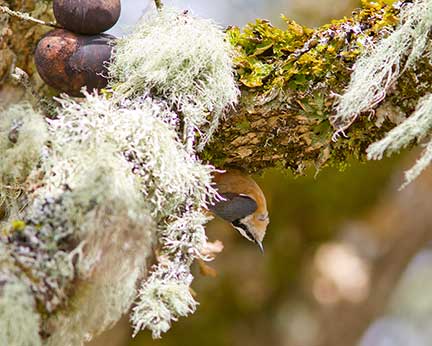 |
Previous Issues |
| Cedar Mill Community Website |
|
Search the Cedar Mill News: |
About The Cedar Mill News |
|
|||||||
| Volume 11, Issue 3 | March 2013 |
||||||
Sounds Like Spring
|
 |
| Red-breasted nuthatch—and yes, the photo is right-side up—these little birds are quite happy hanging upside-down from branches or feeders! Photo ©2013 by Jeff Young. |
In the last few weeks there have been intervals of bright sun, which beckon me outside to see what is happening in the yard. It has been quite the year for moss growth—it is everywhere—on the trees, in the grass and on my paved areas. I also see some budding trees—the plum trees are showing a haze of pink and purple. The Daphne plants are just starting to open up releasing their amazing scent. Such a lovely smell from a small flower!
As I am outside looking at signs of spring in the garden I hear more bird song. The Robins are starting to sing their “Cherrio cheeriup” song—they typically are our first spring songsters starting before sunrise at 4:30 AM. I also see our House Finches starting to claim their high trees and sing their very complex song. The small Red-breasted Nuthatch male has claimed one particularly tall tree and is doing his “ree-ree-ree” call over and over to warn off other males. Very soon our wintering visitors, including the Golden-crowned Sparrows who sing a minor note “oh-dear-me” song, will fly north to establish breeding areas.
The most bizarre bird in my opinion is the very brightly colored Varied Thrush. (I call him the Oregon State— as in OSU Beavers—not the “official” state bird-- with his orange and black “stripes.”) I still marvel at the number of screech and long note whistles that come from that bird. It isn’t really a song but a number of odd notes, which seem so “un birdlike” coming from a bird. If you ever want to listen to actual bird song recordings, the Cornell Ornithology lab has resources on their web site.
We humans have a significant portion of our brains wired to support vision. Compared to other mammals, our brain territory for smell and sound are relatively small compared to our preference for sight. It is often therefore a soothing thing to listen to music or the sounds of nature. It gives the other parts of our brain an opportunity to experience what is right in front of us in new ways. The research about using nature sounds or calming music to help with relaxation is vast. Sometimes we just need to have a different perspective to calm ourselves or to be creative. Think about how different it is to listen more and use our sight less.
I had a very interesting experience last week with shutting off the noise, which surrounds us. I shut off the TV, shut off the electronics and just sat in the dark listening. And I heard a “Who who who who who”-- a five part very soft call outside. I looked out the window and a Great Horned Owl was on my neighbor’s roof calling to another owl. This was such a treat and also a thing I would not have heard if I had continued with the typical noise and patterns of busy-ness.
Take a break. It’s good for the brain, good for the body and good for the soul. You can take a break by being quiet and listening to what surrounds you right now. See what you hear when you are quiet.
Lauretta Young MD is a retired chief of mental health at Kaiser and currently Medical Director of Integrative Self Care Initiative for Students OHSU. She also has a custom bird tour business where she helps people notice birds and bird song and behavior in Cedar Mill and beyond. Check out her web site at www.portlandbirdwatching.com and see more of her husband’s photos at www.flickr.com/photos/youngbirders
![]()
Like us on Facebook for timely updates
Published monthly by Pioneer Marketing & Design
Publisher/Editor:Virginia Bruce
info@cedarmillnews.com
PO Box 91061
Portland, Oregon 97291
© 2013